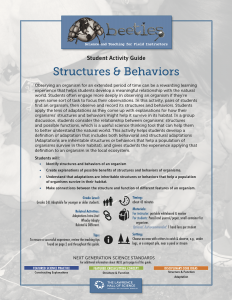Observing an organism for an extended period of time can be a rewarding learning experience that helps students develop a meaningful relationship with the natural world. Students often engage more deeply in observing an organism if they’re given some sort of task to focus their observations. In this activity, pairs of students find an organism, then observe and record its structures and behaviors. Students apply the lens of adaptations as they come up with explanations for how their organisms’ structures and behaviors might help it survive in its habitat. In a group discussion, students consider the relationship between organisms’ structures and possible functions, which is a useful science thinking tool that can help them to better understand the natural world. This activity helps students develop a definition of adaptation that includes both behavioral and structural adaptations (adaptations are inheritable structures or behaviors that help a population of organisms survive in their habitat), and gives students the experience applying that definition to an organism in the local ecosystem.
Students will:
- Identify structures and behaviors of an organism.
- Create explanations of possible benefits of structures and behaviors of organisms.
- Understand that adaptations are inheritable structures or behaviors that help a population of organisms survive in their habitat.
- Make connections between the structure and function of different features of an organism.

